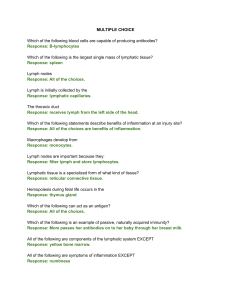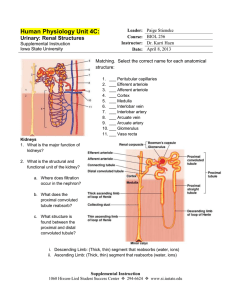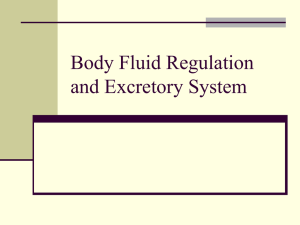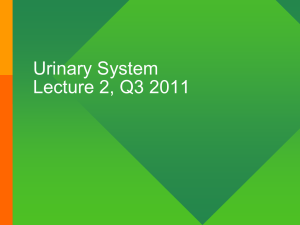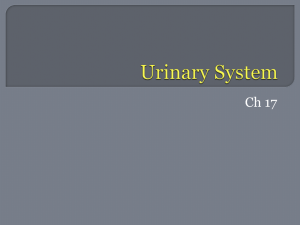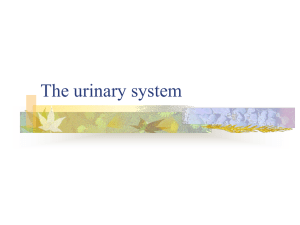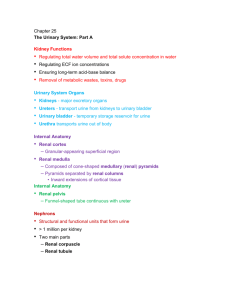Urinary System Practice
advertisement
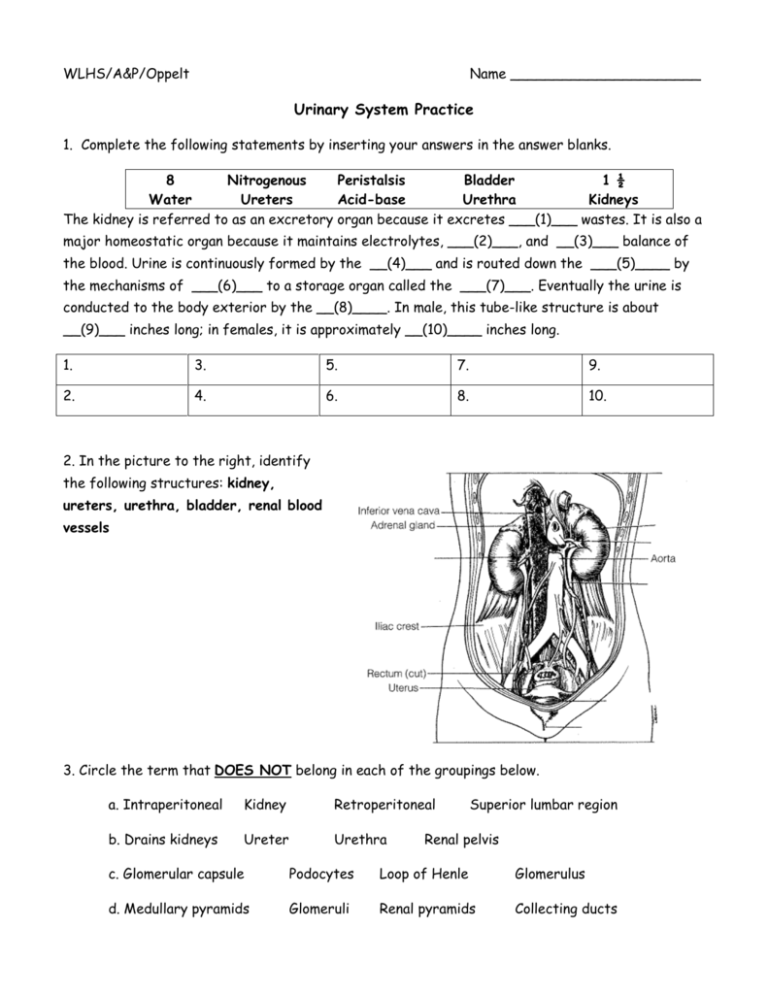
WLHS/A&P/Oppelt Name ______________________ Urinary System Practice 1. Complete the following statements by inserting your answers in the answer blanks. 8 Nitrogenous Peristalsis Bladder 1 ½ Water Ureters Acid-base Urethra Kidneys The kidney is referred to as an excretory organ because it excretes ___(1)___ wastes. It is also a major homeostatic organ because it maintains electrolytes, ___(2)___, and __(3)___ balance of the blood. Urine is continuously formed by the __(4)___ and is routed down the ___(5)____ by the mechanisms of ___(6)___ to a storage organ called the ___(7)___. Eventually the urine is conducted to the body exterior by the __(8)____. In male, this tube-like structure is about __(9)___ inches long; in females, it is approximately __(10)____ inches long. 1. 3. 5. 7. 9. 2. 4. 6. 8. 10. 2. In the picture to the right, identify the following structures: kidney, ureters, urethra, bladder, renal blood vessels 3. Circle the term that DOES NOT belong in each of the groupings below. a. Intraperitoneal Kidney Retroperitoneal b. Drains kidneys Ureter Urethra Superior lumbar region Renal pelvis c. Glomerular capsule Podocytes Loop of Henle Glomerulus d. Medullary pyramids Glomeruli Renal pyramids Collecting ducts 4. In the picture to the right, identify the following structures: calyx major, calyx minor, renal column, renal pelvis, medullary pyramid, renal cortex, and renal capsule 5. In the picture to the right, identify the following structures: afferent arteriole, glomerular capsule, collecting duct, distal convoluted tubule, efferent arteriole, glomerulus, loop of Henle, proximal convoluted tubule, and peritubular capillaries 6. Decide whether the following conditions would cause urine to become more acidic (A) or more basic (B). 1. Protein rich diet _____ 3. Starvation _____ 2. Bacterial infection _____ 4. Diabetes mellitus ____ 5. Vegetarian diet ____ 7. Decide whether the following conditions would result in an increase (I) or decrease (D) in urine specific gravity. 1. Drinking excessive fluids _____ 4. Using diuretics _____ 2. Chronic renal failure _____ 5. Limited fluid intake _____ 3. Kidney infection _____ 6. Fever _____ 8. In the diagram of a nephron below, add the arrows to the diagram indicated in the following statements. a. Black arrows at the site of filtration formation b. Red arrows at the major site of amino acid and glucose reabsorption c. Green arrows at the sites most responsive to action of ADH (show direction of water movement d. Yellow arrows at the sites most responsive to the action of aldosterone (show direction of Na+ movement) e. Blue arrows at the major site of tubular secretion. f. Label the proximal convoluted tubule (PCT), distal convoluted tubule (DCT), loop of Henle, glomerular capsule, glomerulus, and the collecting duct. 9. Complete the following statements by inserting the answers in the answer blank. Microvilli Secretion Afferent Creatinine Urine output Decreases Active transport Evaporation of perspiration 1-1.8 Lungs Cellular metabolism Diet Uric acid Blood plasma Dialysis Efferent Urea Urochrome Diffusion The glomerulus is a unique high-pressure capillary bed because the _ (1)__ arteriole feeding it is larger in diameter than the __(2)___ arteriole draining the bed. Glomerular filtrate is very similar to the _ (3)__, but has fewer proteins. Mechanisms of tubular reabsorption include _(4)__ and __(5)___. As an aid for the reabsorption process, the cells of the proximal convoluted tubule have dense __(6)__ on their luminal surface, which increase the surface area dramatically. Other than reabsorption, an important tubule function is _(7)_, which is important for ridding the body of substances not already in the filtrate. Blood composition depends on _(8)__, _(9)_, and _(10)_. In a day’s time, 180 liters of blood plasma are filtered into the kidney tubules, but only about _(11)__ liters of urine are actually produced. __(12)__ is responsible for the normal yellow color of urine. The three major nitrogenous wastes found in the blood, which must be disposed of, are _(13)__, _(14)__, and __(15)___. The kidneys are the final “judges” of how much water is to be lost from the body. When water loss via vaporization from the __(16)__ and _(17)__ from the skin is excessive, urine output _(18)__. If the kidneys become nonfunctional, _(19)__ is used to cleanse the blood of impurities. 1. 6. 11. 16. 2. 7. 12. 17. 3. 8. 13. 18. 4. 9. 14. 19. 5. 10. 15. 10. Using the choices below, match to the description with the correct structure. A. Bladder B. Urethra 1. ____ Drains the bladder 2. ____ Storage area for urine 3. ____ Contains the trigone 4. ____ Conducts urine by peristalsis 5. ____ In males has prostatic, membranous, and spongey parts C. Ureter 6. ____ Substantially longer in males than females 7. ____A common site of “trapped” renal calculi 8. ____ Contains transitional epithelium 9. ____ Also transports sperm in males



